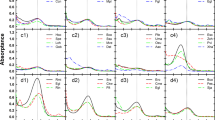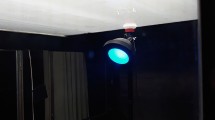Abstract
MANY terrestrial plants of lowland tropical rainforests exhibit a conspicuous blue-green iridescence on their leaves—Richards1 has observed these plants in Africa, South America, and South-east Asia. We have seen many species of blue plants on the rainforest floor in Malaya, from diverse groups including the ferns, Selaginella, and flowering plants. In Malaya the most spectacular and most common iridescent blue plant is Selaginella willdenovii (Desv.) Spring, also frequently cultivated in greenhouses. All comments on the iridescent colour refer back to the observation of Stahl2 who reported the presence of reflection granules in the epidermal cells of S. willdenovii.
This is a preview of subscription content, access via your institution
Access options
Subscribe to this journal
Receive 51 print issues and online access
$199.00 per year
only $3.90 per issue
Buy this article
- Purchase on Springer Link
- Instant access to full article PDF
Prices may be subject to local taxes which are calculated during checkout
Similar content being viewed by others
References
Richards, P. W., The Tropical Rainforest (Cambridge University Press, London, 1952).
Stahl, E., Annls Jardin bot. Buitenz., 13, 137 (1896).
Richards, P. W., in Manual of Bryology (edit. by Verdoorn, F.), 367 (Martins Nijhoof, The Hague, 1932).
Michelson, A. A., Phil. Mag., 21, 554 (1911).
Neville, A. C., and Caveney, S., Biol. Rev., 44, 531 (1969).
Vasicek, A., Optics of Thin Films (North-Holland, Amsterdam, 1960).
Huxley, A. F., J. exp. Biol., 48, 227 (1965).
Gates, D. W., Keegan, H. J., Schleter, J. C., and Weidner, V. R., Appl. Optics, 4, 11 (1965).
Gausman, H. W., and Allen, W. A., Pl. Physiol. Lancaster, 52, 57 (1973).
Evans, G. C., in Light as an Ecological Factor (edit. by Bainbridge, R., Evans, G. C., and Rackham, O.), 53 (Blackwell, Oxford, 1965).
Federer, C. A., and Tanner, L. B., Ecology, 47, 555 (1966).
Bjorkman, O., Carnegie Institution Year Book, 71, 82 (1972).
Author information
Authors and Affiliations
Rights and permissions
About this article
Cite this article
LEE, D., LOWRY, J. Physical basis and ecological significance of iridescence in blue plants. Nature 254, 50–51 (1975). https://doi.org/10.1038/254050a0
Received:
Revised:
Issue Date:
DOI: https://doi.org/10.1038/254050a0
This article is cited by
-
The hybrid nature of Danaea plicata (Marattiaceae), a Costa Rican endemic
Brittonia (2018)
-
Structural colour in Chondrus crispus
Scientific Reports (2015)
-
Ultrastructural basis and function of iridescent blue colour of fruits inElaeocarpus
Nature (1991)
-
Physiology of flower bud growth and opening
Proceedings / Indian Academy of Sciences (1984)
Comments
By submitting a comment you agree to abide by our Terms and Community Guidelines. If you find something abusive or that does not comply with our terms or guidelines please flag it as inappropriate.



